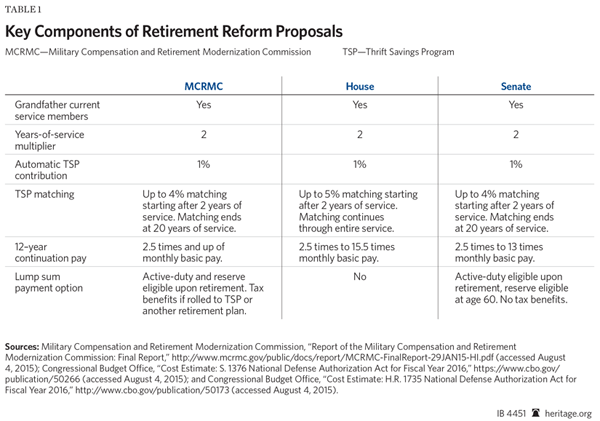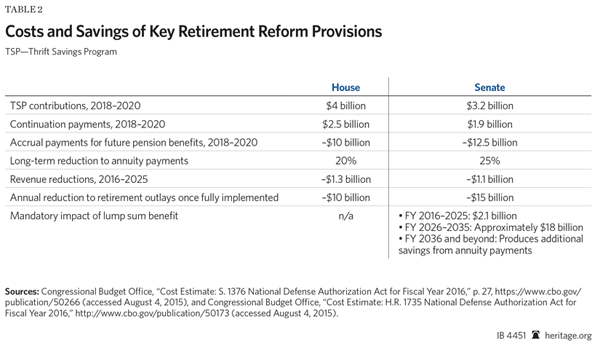Both the House of Representatives and the Senate have passed versions of the fiscal year (FY) 2016 National Defense Authorization Act (NDAA). The two chambers are now negotiating a final bill, but according to press reports, the negotiators are stuck on the details of a major military compensation and retirement reform proposal. Both chambers of Congress included a similar major reform in military retirement, but each differs in the specifics of the benefits and how to pay for them.
When considering this debate, a few things should be kept in mind.
First, when discussing Department of Defense (DOD) personnel and benefits reforms, there are two basic ways to achieve financial savings: change the system or pass the costs on to the service members. The reform proposals outlined below include examples of both. Increasing the enrollment fee for TRICARE—the health care program for uniformed service members—is passing a cost directly to a service member or military retiree. An investment-based retirement system, on the other hand, uses the power of markets to create value for service members and reduce costs to the government and, hence, to taxpayers. Increasing TRICARE co-pays likely has a bit of both: Some costs are passed to service members, but by incentivizing certain behaviors (using preferred facilities or generic drugs), systemic savings can also be achieved.
Second, many argue that rising personnel costs are a major problem for DOD. Former Secretary of Defense Robert Gates famously stated that “health care costs are eating the Department of Defense alive.”[1] At the same time, others argue that DOD’s personnel costs are not problematic because the share of the DOD budget for personnel costs has remained fairly steady over time.[2]
An analysis of the DOD budget shows that both sides are somewhat correct. Military pay and benefits constituted 34.6 percent of DOD’s budget in 2001 and 35.5 percent of the budget in 2015.[3] However, the cost per service member has risen dramatically. In 2014 dollars, the cost per service member has gone from roughly $93,000 in 2001 to approximately $133,000 in 2015, an increase of over 40 percent.[4] By comparison, the cost per DOD civilian employee increased by just under 20 percent over the same period. Since 2012, however, the inflation-adjusted cost per service member and per civilian has been remarkably static.
Specific Compensation Issues
The following specific military compensation issues are being considered in the NDAA conference.
Pay Raise. The formula in existing law would lead to a 2.3 percent pay raise in January 2016. The House is silent on the issue, in effect supporting the 2.3 percent pay raise. The Senate supports the President’s budget request of a 1.3 percent pay raise and also would prohibit a pay raise for general officers. The Senate position saves $717 million in FY 2016 and $4.8 billion over five years.[5] Unless Congress explicitly enacts the 2.3 percent pay raise into law, the President can waive current law and implement the lower pay raise.
Basic Allowance for Housing. Basic Allowance for Housing (BAH) is a tax-free payment that service members receive to cover the cost of their housing, which is based on the average rental costs in particular geographic areas. The FY 2015 NDAA reduced BAH from 100 percent to 99 percent of the area average rental cost. The President’s budget proposed reducing BAH from 99 percent to 95 percent of area average rental cost. The House bill does not allow for this reduction. The Senate bill includes the BAH reduction, which saves $389 million in FY 2016 and $3.8 billion over five years.[6]
BAH Reduction for Married Couples and Housemates. Under current law, two service members who are married can each receive BAH regardless of whether they live together or separately. Additionally, non-married service members can live together and still receive the full amount for BAH. The Senate prohibits married service members assigned to the same duty location from both receiving BAH and reduces the BAH for unmarried service members who live together. This saves $77 million in FY 2016 and $1.7 billion over five years.[7] The House is silent on this topic.
Commissaries. The Defense Commissary Agency runs 241 stores around the world, including 178 in the United States, to sell groceries to service members and retirees at cost plus 5 percent. The 5 percent surcharge does not cover the full operating costs, so each year an appropriation is required to cover this deficit. In 2014, DOD contributed $1.4 billion to subsidize the commissaries.[8] The President’s budget proposed reducing this subsidy and making a variety of changes in how commissaries operate, which would reduce the subsidy by $322 million in FY 2016 and save $4.4 billion over five years. The House bill prohibits these changes and includes funds to pay for the FY 2016 costs of the current program. The Senate does not add additional funds and allows some of the proposed reforms to be implemented.[9] A Heritage Foundation paper has recommended cutting the commissary subsidy.[10]
Retirement. In January 2015, the Military Compensation and Retirement Modernization Commission (MCRMC) issued its final report, in which it proposed a significant overhaul of military compensation and retirement.[11] One of the most significant proposals is to move from a defined-benefit retirement plan to a blended-benefit retirement plan.
Today, service members who serve for 20 or more years earn a pension (“defined benefit”) and can contribute their own funds to the government’s version of a 401(k) retirement plan, the Thrift Savings Program (TSP). The MCRMC proposed reducing the pension for those who serve 20 or more years in exchange for government contributions to the TSP. Under the current system, 83 percent of enlisted service members and 51 percent of officers do not receive any government-sponsored retirement benefit for their military service.[12] Both the House and the Senate included blended retirement plans starting in FY 2018, but with some differences. A Heritage Foundation paper supports military compensation reform.[13]
One area of difference between the House and the Senate is the lump-sum payment option. The Senate includes a provision allowing a military retiree to receive a lump sum upon retirement in exchange for not receiving monthly pension checks until the age of 67. The service member could also choose to receive half of the lump sum and still receive half of his or her pension payments until age 67. In both scenarios, full pension payments would resume at age 67. According to the Congressional Budget Office (CBO), the average lump-sum payment would exceed $250,000.[14] This lump sum would give military retirees access to capital immediately upon retirement and would enable them to buy property, pay for a child’s college tuition, or start a business.
However, the lump-sum benefit is financially complicated for the government. If a service member chooses to receive a lump sum, the government is paying more to the service member up front and less over the long term. For budgetary purposes, this means that there is increased mandatory spending in the near term in exchange for reduced mandatory spending over the longer term. The CBO estimates that the lump-sum benefit would increase mandatory spending by $2.1 billion from 2018 to 2025 and would accelerate in the following decade:
The increase in spending would accelerate beyond 2025, as an increasing number of military members would be bound by the rules of the new retirement system and would thus be eligible for a lump-sum payment when they retire. Eventually, however, the savings from the reduced and foregone annuities would exceed the annual spending on lump-sum payments.[15]
TRICARE. The President’s budget proposed a number of changes in TRICARE. These changes were proposed in addition to a series of changes that have been instituted by the FY 2012, FY 2013, FY 2014, and FY 2015 NDAAs. In the FY 2015 NDAA in particular, TRICARE pharmacy co-pays were increased by $3, and maintenance drugs were required to be dispensed only via on-base pharmacies or via mail order.[16]
The President’s budget also proposed consolidating the various TRICARE health plans, adding an enrollment fee for TRICARE-for-Life and increasing pharmacy co-pays. The House does not accept any of the President’s proposed changes in TRICARE.
The Senate, however, does include the TRICARE pharmacy co-pay increases. Under the Senate bill, pharmacies on military bases will still provide free prescriptions to eligible recipients. However, starting in FY 2019, the co-pay for generic prescriptions purchased at retail pharmacies will go up by $1 per year. Co-pays for brand name and non-formulary drugs will be increased as well. The CBO estimates that this change will save $2.3 billion in discretionary funding in the first five years. TRICARE co-pay increases will also affect mandatory spending and in this case will save $1.4 billion over the first five years and $3.8 billion over the first 10 years.[17]
Impact on the Federal Debt
According to the CBO, the House bill increases the national debt by $330 million over the first five years and a total of $1.3 billion over the first 10 years. This is due to the decreased income tax revenue as service members contribute to the TSP. However, once the retirement provisions are fully implemented, the bill would save approximately $10 billion per year.[18]
The Senate also reduces tax revenue by $1.1 billion due to TSP contributions. However, the Senate reduces the deficit by $1.96 billion in the first five years and a total of $3.8 billion over the first 10 years. This is due primarily to the TRICARE pharmacy co-pays and BAH reductions for veterans on the GI Bill. However, due to the lump-sum provision, the CBO believes that in the decade after 2025, this bill will increase deficits by approximately $18 billion.[19] These lump-sum payments would be offset in subsequent decades but would take time to accrue.[20]
Enacting Major Reforms
Military personnel are the most important part of America’s national defense. In addressing compensation and benefits for military personnel along with the full range of federal programs, Congress should take appropriate account of the nation’s need to both (1) reduce federal spending and ensure effective use of taxpayer resources, and (2) provide a strong national defense, including by continuing to attract to and retain in military service highly qualified, talented, and experienced individuals. As it finalizes the FY 2016 NDAA, Congress should therefore:
- Focus on the most important reforms. The introduction of a blended-benefit retirement system will be of significant value to the vast majority of service members who do not receive any government-sponsored retirement benefit today. It will also produce significant savings, which will allow DOD to focus on its primary task of protecting America.
- Protect married service members. Married service members should not be financially penalized for being married. This is unfair and discourages those in uniform from committing to marriage.
- Be clear about the costs and benefits of the lump-sum proposal. The lump-sum benefit is a good policy that gives service members more options and produces savings for DOD. However, the lump-sum proposal also carries a significant mandatory spending cost.
- Reform TRICARE entirely. Increasing pharmacy co-pays does not address the larger reforms in TRICARE that need to be made. Instead, Congress should move service members and their dependents into the same commercial health insurance system that federal employees use.[21]
—Justin T. Johnson is Senior Policy Analyst for Defense Budgeting Policy in the Douglas and Sarah Allison Center for Foreign and National Security Policy, of the Kathryn and Shelby Cullom Davis Institute for National Security and Foreign Policy, at The Heritage Foundation. Carl Best, an intern at The Heritage Foundation, contributed to this paper.




